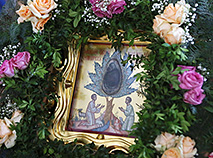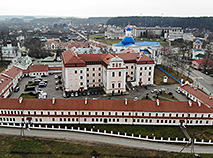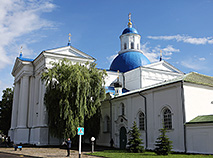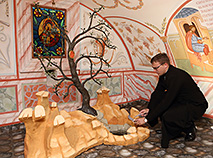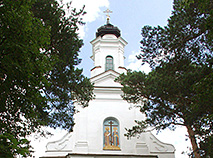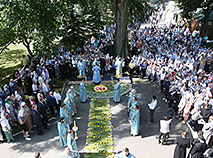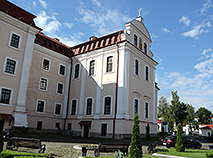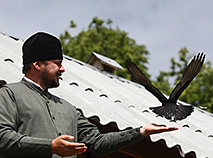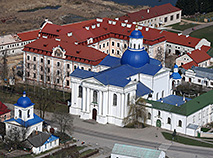Zhirovichi Monastery
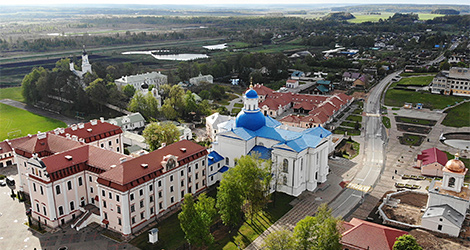
Belarus’ national treasure, a place of amazing history and spiritual power, a many-century keeper of the legendary shrine – the Zhirovichi Icon of the Mother of God… Founded in 1520, the Holy Dormition Zhirovichi Metropolitan Male Monastery has never closed. Today it is the largest Eastern Orthodox church complex of the country.
Zhirovichi Icon of the Mother of God
The history of the spiritual center in the town of Zhirovichi began more than half a thousand years ago with the miraculous appearance of the Icon of the Mother of God. A legend has it that this happened in 1470.
In a forest owned by Treasurer of the Grand Duchy of Litva (Lithuania) Alexander Soltan, shepherds noticed a bright light breaking through the branches of a wild pear tree. As it turned out, it came from a small image of the Virgin and Child. The shepherds took the image down from the tree and took it to the landlord, but he did not pay attention to the story and locked the icon in a casket.
In the evening, Soltan decided to show the find to the guests but… it was gone. The following day, the shepherds again saw the image of the Virgin on the same pear tree and brought it to the nobleman. That time the landlord accepted the icon with reverence, vowing to build a temple on the site of its appearance. A new church was built in honor of the icon called the Zhirovichi Icon.
Around 1520, a fire broke out in the town. The wooden church burned down, and the icon was never found in the ashes. Only the church school survived. One day local children wandered off to the hillock and saw the Mother of God radiating light and holding the lost shrine in her hands. The children hurried back to the village and called the adults who found the miraculous image on the boulder with a candle lit next to it. That was the second appearance of the Zhirovichi Icon.
The amazing history of the icon and the miracles that it worked turned Zhirovichi into a place of pilgrimage. Pilgrims began to come here not only from nearby villages and towns but also from distant places. The icon cured people of their ailments and gave them much-needed spiritual help.
The Zhirovichi Icon of the Mother of God was coronated in 1730. An expensive cover for the icon was made then too.
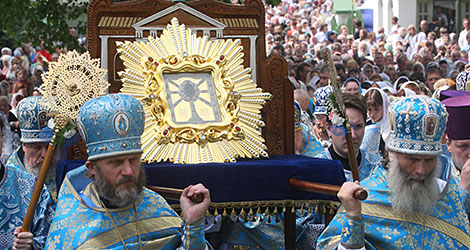
The Zhirovichi Icon is known not only as a wonderworking icon but also as a unique piece of art, historical and cultural asset. This is the smallest of the most respected icons of the Mother of God. The icon is an oval piece of jasper (5.6x4.4cm) with a relief image of the Mother of God holding the infant Jesus. It is respected both by Orthodox and Catholic believers and is on the list of the 100 most valued Orthodox icons in the world.
The icon rarely leaves the monastery: the ministers try not to move it because of its fragile condition. But most importantly, monks want the joy of revering the icon to be experienced in the monastery. The exact copy, which was made in 1996, is usually used during public events.
The day of the appearance of the Zhirovichi Icon of the Mother of God is observed on 20 May. Every year, many pilgrims flock to the monastery for a large celebration.
History
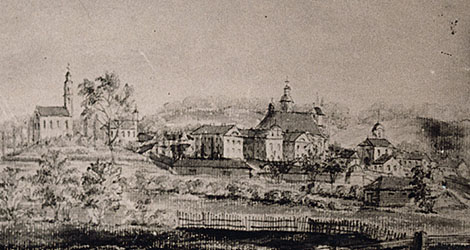
The Zhirovichi Monastery is the country’s largest religious center, a stronghold of the Orthodox faith, which, however, has experienced ups and downs throughout its history. It was Orthodox and Uniate, destroyed and restored, forgotten and brought back to life. Yet, it has never ceased to be and has always served as a refuge for believers.
In the 16th century, following a great fire that burned down the first wooden temple, a stone church was built following the new appearance of the Zhirovichi Icon, and an Orthodox monastery was founded.
With the adoption of the Union of Brest in the early 17th century, the monastery was transferred to the Uniates, and Bishop Josaphat Kuntsevych, one of the most influential religious figures of that time, became its head. For more than two centuries, the Zhirovichi Monastery remained the center of Uniatism in the Grand Duchy of Litva (Lithuania).
In 1839, a time of the Russian Empire, Bishop Joseph Semashko, who was favored by Emperor Nicholas I, converted to Orthodoxy together with the priesthood and the brethren, and the monastery was returned to the Orthodox Church.
In 1921-1939, Grodno Province was part of Poland. At that time the monastery housed an agricultural school, with ten monks continuing to live on its grounds.
The monastery was functional in the harsh years of the Second World War (none of its buildings was hit by a bomb and a shell!), and in difficult times of atheism. In 1945, the monastery launched theological and pastoral courses which soon gave rise to the Minsk Theological Seminary. With time the authorities began to hinder the enrollment and closed it altogether in 1963. In 1989, it reopened thanks to Metropolitan Filaret (Vakhromeyev), who was the archimandrite of the Zhirovichi Monastery from 1975 to 2013.
From 1996 to 2015, the Minsk Theological Academy was also based in the Zhirovichi Monastery.
In the early 1960s, the Zhirovichi Monastery gave shelter to nuns of two convents, the Nativity of the Theotokos of Grodno and Savior and St. Euphrosyne Convent of Polotsk, that were closed down.
In 1992, the Zhirovichi Monastery received the stavropegial status. Today it is the spiritual center of the Belarusian Exarchate and the largest monastery in the country.
In February 2020, the year marking the 550th anniversary of the miraculous Zhirovichi Icon and the 500th anniversary of the monastery, the cloister was gifted the book The All-Joyful Intercession of Belaya Rus. It was authored by Mother Superior Gavriila of the Holy Nativity of the Mother of God Stavropegic Convent in Grodno. The book is a collection of ancient written sources, legends, memories of local residents. It is interesting that the future mother superior spent her childhood and youth years in Zhirovichi.
Architectural Ensemble
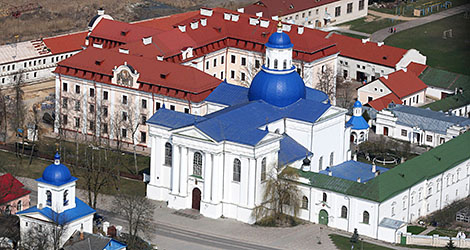
The Holy Dormition Stavropegic Monastery in Zhirovichi is Belarus’ largest architectural ensemble of the 17th–18th centuries. This huge complex took many years to build. It combines elements of various architectural styles - Baroque, Rococo, Classicism. To date, the monastery complex includes five churches, a bell tower with a chapel, old and new (1956) seminary buildings, a brethren’s building, a household building and other ancillary buildings, refectories, houses for pilgrims …
Temples of the Zhirovichi Monastery:
-
Holy Dormition Cathedral
-
St. Nicholas Church (attached to the cathedral)
-
Theophany Church
-
Church of the Holy Cross
-
St. George’s Church (an 18th century wooden building near the old monastery cemetery)
The main church of the Zhirovichi Monastery - the majestic Holy Dormition Cathedral - was built in the period from 1613 to 1650. The construction works were funded by Zhirovichi owner, castellan Ivan Meleshko. Great contribution to the construction was made by Chancellor of the Grand Duchy of Litva (Lithuania) Lev Sapieha.
The cathedral has been repaired and rebuilt several times throughout its history. According to sources, the most drastic changes took place in 1655, 1760, 1821, 1867. Therefore, it is not surprising that the main cathedral of the monastery combines elements of Baroque, Late Classicism, features of Byzantine (basilic) church architecture. The cathedral is about 40m high and 55m long. It has retained the Baroque architectural decoration inside.
Initially, the cathedral had only a central iconostasis, which has been well preserved to this day. It was painted in the Baroque style by Grigory Medvedsky at the end of the 18th century. Side iconostases appeared here in the 1860s. The walls are decorated with murals from different periods. Here you can see images of the four evangelists, the most revered saints, and depiction of church holidays.
The main altar of the cathedral was consecrated in honor of the Dormition of the Most Holy Theotokos, the right aisle - in honor of the Intercession of the Most Holy Theotokos, the left aisle - in honor of the Nativity of the Holy Forerunner and Baptist of the Lord, John.
In the 17th-18th centuries large cellars of the church had a burial vault for local monks and nobility. The vault was bricked up at the beginning of the 19th century, so the dead began to be buried in the brethren’s cemetery.
St. Nicholas Church is attached to the cathedral through a common entrance. This stone church looks like an early Christian temple. It is here where the Zhirovichi Icon is kept during the cold season.
The Church of the Nativity of the Mother of God, known today as Theophany Church, was erected around 1672 on the site where, according to a legend, the Zhirovichi Icon appeared for the second time in 1520. The stone, on which children saw the Mother of God, was placed in the altar under the throne. In 1796 the church was completely rebuilt.
There is another amazing story about this church and it revolves around the appearance of the icon in the 20th century. During the Great Patriotic War, the Nazis set up an ammunition depot in the church, and the sentries said that a Woman would appear at night and order them to leave the monastery before she would mysteriously disappear. The Germans thought that it was a partisan and accused the archimandrite of hiding her, but when they searched the grounds they found an icon of the Mother of God who looked exactly like that stranger. After that, to the surprise of the monks and local residents, the Nazis left the monastery never to return.
The unique one-nave Church of the Holy Cross was built of stone in 1769. This is a calvary temple dedicated to the pilgrimage to Jerusalem that was widespread in the 18th century. Most of the building inside is occupied by a staircase - a copy of the legendary Holy Staircase (Scala Sancta), which leads to the Sancta Sanctorum papal chapel in the Lateran Palace in Rome. The Zhirovichi church is the world’s only church that uses the same solution: just like in Rome, local pilgrims can climb the 28 steps of the stairs on their knees reciting special prayers.
St. George’s Church (George the Victorious) is a wooden Baroque temple of the late 18th century located away from the monastery courtyard and on the outskirts of Zhirovichi near an old cemetery. From time immemorial this place has been called George’s Hill. It offers a delightful view of the monastery ensemble.
A late Classicism bell tower is another iconic building and a symbol of the monastery. It is located across the road opposite the Holy Dormition Cathedral and has the same outlines. The first tier is a chapel with columns, the second one is a domed belfry. The bell tower was erected in Zhirovichi in 1828. A decade later the monastery was returned to Eastern Orthodox believers after a two-century Uniate period. The return became possible thanks to Bishop Semashko and due to the establishment of the first Theological Seminary.
Restoration works have been ongoing in the Zhirovichi Monastery for 30 years already. The guest infrastructure is being improved. In addition, new facilities were built here in the run-up to the 50th anniversary: a refectory and a hotel stylized as outbuildings of the 18th-19th centuries.
Shrines of the monastery
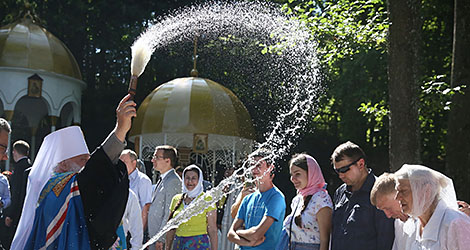
The Holy Dormition Cathedral is the abode of the monastery’s main relic - the icon of the Mother of God of Zhirovichi. Interestingly, in the winter period the image is kept in the neighboring St. Nicholas Church, because it is warmer there.
Some of the country’s most famous holy springs are located on the premises of the Zhirovichi Monastery:
-
Holy spring under the Holy Dormition Cathedral
-
Far Holy Spring of the Mother of God
-
Near Holy Spring
According to a legend, the emergence of the first spring coincided with the appearance of the icon of the Mother of God. It was spotted at the foot of a pear tree in 1470. Soon a church was built here, and today this ancient spring is located under the Holy Dormition Cathedral.
Two more springs flow far from the cathedral, but they are also connected with the first one. Water from the Zhirovichi springs is unique and is believed to have healing properties.
The famous Far Holy Spring is located two kilometers from the monastery. It was consecrated more than 200 years ago and is also known for its healing power. Many decades ago a bathhouse was built for pilgrims who flocked here from around the world. It was refurbished in 2019 and reopened for believers.
The Near Holy Spring was consecrated in the name of the Mother of God in 2006. It is located on the road to Ivatsevichi. There are two baths here: for men and for women.
The famous Zhirovichi Gospel was kept in the monastery until the mid-19th century. The book was handwritten in the 15th century, it has 404 sheets and is adorned with beautiful miniatures, headpieces, and initials. Chancellor Lev Sapieha made an inscription in this book saying that he donated the land to the monastery, which gave the book its second name - The Gospel of Sapieha. Now this religious artifact is kept in the Library of the Lithuanian Academy of Sciences.
Zhirovichi Monastery Today
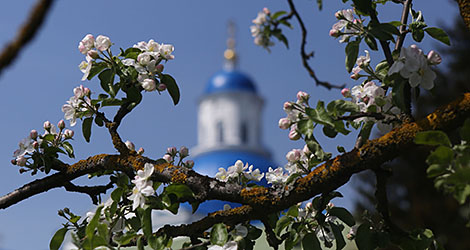
Archimandrite and Rector of the Holy Dormition Stavropegic Monastery in Zhirovichi - Metropolitan Veniamin of Minsk and Zaslavl, Patriarchal Exarch of All Belarus
Father Superior of the Holy Dormition Stavropegic Monastery in Zhirovichi and Rector of the Minsk Theological Seminary - Archbishop Gury of Novogrudok and Slonim
There are 33 monks in the monastery.
Zhirovichi is home to a higher theological educational institution of the Belarusian Orthodox Church - Minsk Theological Seminary named after Ecumenical Teachers and Hierarchs Basil the Great, Gregory the Theologian and John Chrysostom. It trains clergymen, theologians, teachers, church workers to serve in parishes, diocesan and synodal institutions, spiritual educational institutions, foreign missions, other church and secular organizations.
The monastery also runs the Anastasis rehabilitation center for alcohol and drug abusers (village of Sosnovka, Slonim District).
The Zhirovichi Monastery hosts pilgrims year-round. They can stay overnight (men and women separately). Those wishing to spend a few days here follow the rules of the monastery, including prayers, services, and work for the benefit of the monastery.
For those coming for a day there are excursions available from 9:00 to 16:00. Pilgrims can learn the history of the Zhirovichi miraculous image of the Mother of God, the past and present of the monastery, and its shrines. Tours are run around four temples, the monastery cemetery and the Minsk theological seminary.
Another interesting place to visit is the courtyard of the Zhirovichi Monastery, located at the site of the former Soltan estate: unfortunately, only ruins survived to the present day. These lands alongside with the ancient apple orchard were given to the monastery. The locals have not only revived the orchard but also set up a farmstead which is also open to visitors. There is a herd of horses, and also poultry, pig and fish farms and the “Garden of Eden” which is home to various kinds of wild animals.
Museum of the Minsk Theological Seminary
The Church and Archaeological Museum of the Minsk Theological Seminary was founded in 2014 on the initiative of the rector - Archbishop Gury. Every year the museum collection expands with unique rarities. Many of them are still little studied, so visitors are likely to learn a lot of interesting facts and discoveries.
The museum has 5 halls, the expositions of which are devoted to the history of:
-
Zhirovichi Monastery,
-
Minsk Theological Seminary,
-
Spiritual education and enlightenment in the Belarusian lands,
-
church art,
-
church books.
Location
Address: 57 Sobornaya Street, agro-town of Zhirovichi, Slonim District, Grodno Oblast
The agro-town of Zhirovichi is situated 197km away from Minsk and 148km from Grodno. The most convenient way to get there is by car or by bus as part of an organized group of tourists. You can also reach the place by bus running between Minsk and Slonim and Slonim and Zhirovichi. Trains of regional, interregional and international lines run through the Slonim railway station.
Places of interest near Zhirovichi Monastery
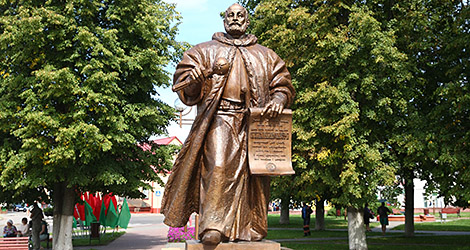
Zhirovichi Monastery is only 10km away from Slonim - a town with a rich history, one of the oldest places in the Belarusian lands.
In the 16th century Lev Sapieha, a famous politician and thinker, the Chancellor of the Grand Duchy of Litva (Lithuania), was the headman of Slonim. Thanks to him, in 1591 the town confirmed the Magdeburg right it received in 1531 and was also given its coat of arms. Under Sapieha, Slonim became a developed center of crafts and trade, and a vibrant political life.
Another prominent figure became the town mayor in the 18th century. It was Hetman of the Grand Duchy of Litva (Lithuania) Michał Kazimierz Ogiński, a philanthropist and composer, the uncle of Michał Kleofas Ogiński, the author of the Farewell to the Motherland polonaise. On the site of the wooden castle, he built a magnificent palace featuring a theater, music and ballet schools, a printing house, a manege, a greenhouse, a pond, and a garden. Unfortunately, the estate has not survived to the present day. Slonim, however, prides itself on the Oginski Canal, built in 1767-1783. Interestingly, the sluices were often opened during the plays, and the actors performed while sailing along the river. Today this picturesque artery between the Yaselda River and Shchara River, a magnificent example of hydraulic engineering on par with the Augustow Canal, is being revived as a tourist attraction.
Other attractions of Slonim include:
-
Holy Trinity Cathedral (17th century) and the buildings of the old Bernardine monastery (17th-18th centuries)
-
Church of St. Andrew the Apostle (1775)
-
Cathedral of the Transfiguration of the Savior (built in 2005 on the place of the old cathedral that did not survive till our times)
-
Church of the Immaculate Conception of Saint Virgin Mary (Bernardine Church)
-
the synagogue (a monument of Baroque defensive architecture, 1642, one of the most significant Jewish temples in Europe, has been under restoration for many years); in Slonim there are also other synagogue buildings, which include a store and a college gymnasium.
-
the town hall (mid 17th century; is a library today)
-
artisan houses and a guest house (the second half of the 17th century).
-
the 20th-century monuments – a bank in Art Nouveau style (1905), a railway station and a water tower (1922), a town house of the early 20th century, a post office, and dwelling houses.
Slonim is also home to Albertin, the former country estate of the Puslowski counts (early 19th century), which features a two-storied estate, an outbuilding, stables, and a landscape park near the lake.







 print version
print version make home page
make home page add to bookmarks
add to bookmarks